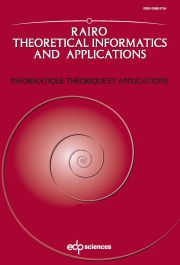Crossref Citations
This article has been cited by the following publications. This list is generated based on data provided by Crossref.
Tijdeman, R.
and
Zamboni, L.Q.
2009.
Fine and Wilf words for any periods II.
Theoretical Computer Science,
Vol. 410,
Issue. 30-32,
p.
3027.
Holub, Štěpán
2011.
Corrigendum: On multiperiodic words.
RAIRO - Theoretical Informatics and Applications,
Vol. 45,
Issue. 4,
p.
467.
Blondin Massé, Alexandre
Gaboury, Sébastien
and
Hallé, Sylvain
2012.
Developments in Language Theory.
Vol. 7410,
Issue. ,
p.
308.


